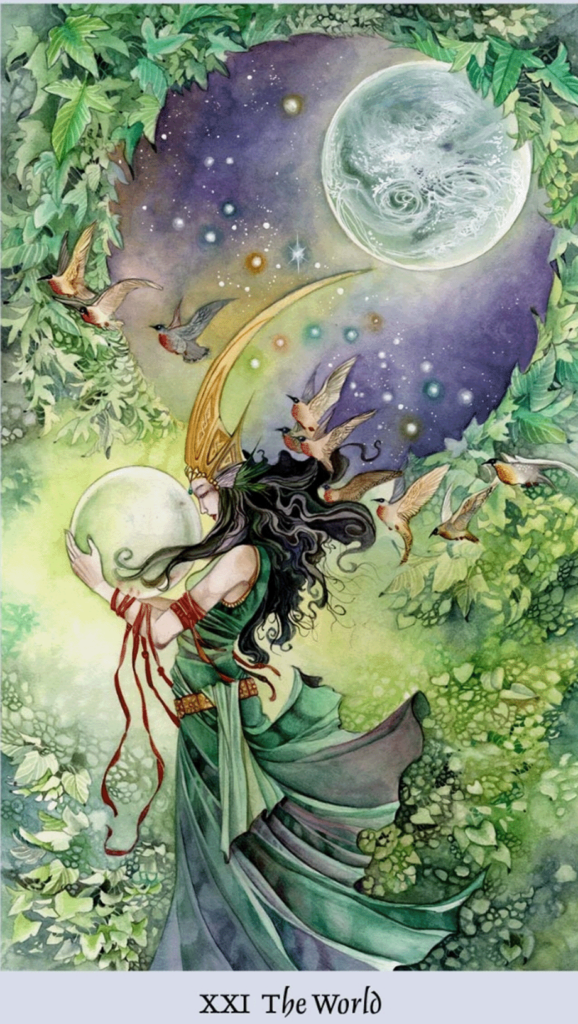Another Earth Day has come and gone. This seems to have passed with little hooplah or recognition, but then I have made the choice to no longer look at the majority of the media, so it may be a skewed observation.
The witch accounts I tend to follow on the socials mostly mentioned it. But witches live with the Earth daily, or so we say. I actually was quite displeased with myself when considering that point.
I was taking the trash out, which in itself is a problem. It is a consequence of living in the burbs, I know, in that all our waste products have to go into some sort of managed system to keep down the potential of contagion when so many people “decide” to live so closely together.
But it got me thinking.
We’re an empty nest. Our children have grown to the point of moving out, so it is just myself, my wife, and currently five rather overindulged felines. Our neighborhood homeowner’s association dues cover trash pickup twice weekly. In actual fact, I take the trash out to the curb for pickup maybe 4.25 times per month. That is, once a week, but not always twice a week.
But I am still taking the trash out. Trash is still being generated at a rate that requires I remove it from my property at least weekly. I really need to consider doing better than that.
When I was a child back in the hills of Eastern Kentucky, we did not live in a suburb with HOA dues and regular trash pickup. I am not sure if that has changed since I left. I know a lot of “services” have been imposed by the local municipality that now technically has expanded to include the smallish plot on which I was raised.
But in those days, we did not seem to be creating as much garbage from a family of four with an extended family group of seven, three or four dogs, and a multitude of cats, and from time to time a hog or two.
In the first place, we lived a more frugal lifestyle. Not out of choice, but purely from necessity. Food waste was a rare thing. You ate leftovers until they were gone, and you took care to keep them from being spoiled before you could eat them. Anything that was marginal or did not reheat well, probably supplemented the diet of the aforesaid dogs, cats, and especially the hogs. Hogs are a natural disposal for organic waste products, and they appear to like it.
So this then leaves other kinds of waste products, which cannot be consumed or composted (which was another thing typically done, though we didn’t call it that).
Forty or so years ago, much of what currently comes in “recyclable” plastic was dispensed in glass bottles.

Soft drinks and some alcoholic beverages were sold in glass bottles that required a “deposit”. Because glass was so durable, and so easy to sanitize and reuse, manufacturers actually wanted you to bring them back so they could refill them. Hence, if you didn’t bring back that 8 bottle carton of empty Coke bottles, you were charged and additional fee for the new ones. Typically this was a nickel a bottle when I was a child.
There was a secondary consideration here, in that if you brought back bottles you could get that five cents, so people frequently patrolled public areas looking for bottles that were littering roadsides and parks.
But cheap, “recyclable” polymer bottles replaced the glass market, because profitability. Sell big two and three liter bottles of soft drinks in a giant plastic jug. No more broken glass bottles that might cut people. But fast dispensing, quick consuming sugar loaded goodness in simply plastic jugs, which could be “recycled”.
The trouble with that, of course, is that now one was recycling. Recycling of plastics was hardly an option in a great number of American communities when the plastic overtook the glass which was being reclaimed, reused, recycled, and disposed of using an industry that went back hundreds of years.
But the corporations were making more money and generating better stockholder value and onward we went.
About the same time, the brown paper grocery bag that was the default from about the mid-twentieth century began to disappear in favor of the flimsy plastic “t-shirt” bags now prevalent in every grocery store that “reminds you to bring your reusable bags”. I think Aldi, Trader Joes, and a few places like Whole Foods or Sprouts are still offering the paper bags as an option.
The plain brown unadorned paper bag had a multitude of uses. It was never thrown away. It was used to carry things. It was used to wrap packages. It was used stop up drafts in the windows in winter. It was also used as a trash bag for those things which could not be consumed or composted or were recycled reused glass.
But plastic was quicker and cheaper and no one cared about how many sea turtles it was going to strangle because, hey, it could be recycled. Somewhere. In some big city. Maybe.
I don’t know about the big cities in the 70s and 80s because I didn’t live in them. Country folk had their own means of recycling glass and plastic that didn’t have deposit cash incentives. They reused them. They used them most often to store those leftovers mentioned earlier. They became useful containers around the house for non-food items. Jars were frequently used for buttons and screws and nuts and bolts. Plastic bowls and tubs were used for paint, or other materials, when not storing food. The big plastic gallon jugs that milk came in were cleaned and used to store water, or other drinks. They’d often be frozen in summer and taken out in the mornings to the fields, so that as the day went on they’d naturally thaw and become cold water to drink.
Aluminum was typically collected and taken for recycling because, like the soda bottles, it was a source of supplemental income, as it is today for some people.
This basically leaves behind paper waste that cannot be reused (and we reused a lot) and non-aluminum food storage – a.k.a. the “tin can”. There was a minimal amount of polystyrene foam waste from meat packing as well. The paper waste and the polyfoam, along with some plastic that was “used” up made it’s way to a burn pile or burn barrel once every couple of weeks.
Yes, I know this is hardly eco-friendly or carbon neutral, but remember it’s still a lot less than is being produced by slash and burn agriculture and other industrial processes. And in colder months said burning was frequently in the fireplace or heat stove, and used to reduce consumption of fossil fuel-based electrical energy.
The waste of metal can packaging was also somewhat minimal, because a lot of the things that came in tin cans, like vegetables, we grew ourselves. And we preserved them ourselves, in glass jars, that were reused from the previous year’s “canning”. So only a few things came in tin cans, namely coffee, tinned fish like salmon, and potted meat (SPAM). And coffee cans, like the empty butter bowls and jelly jars, were put to new use for storage.
In the end, we went to the “city dump” maybe twice a year, with that stuff that we simply could not find a use for, or dispose of ourselves.
Wood, stone, building materials, cloth, furniture, crockery, china, and “yard waste” were all reused, recycled, or consumed. None of that went to the dump. Even pieces of glass and ceramics were frequently just broken up and buried somewhere on the family property, or used as infill with masonry.
I can’t burn trash in my neighborhood. Officially anyway. A backyard “firepit” can cover a multitude of sins, but even then it’s not practical. So much of what comes into our houses, like the plastic bottles and plastic bags, is designed for hauling back off to a “landfill” or other type of industrial waste disposal facility.
In fact, the high price I pay for trash pickup does not include recycling, though incorporated urban areas and some suburban ones have it required. I do recycle. But it must be an active choice, that requires me to separate, collect and then deliver that material personally to the facility, because the contracted garbage service doesn’t do it.
And I save and reuse paper and plastic bags, bowls, boxes, bottles, and other paper as much as I can. I try to repurpose things like packing foam and other persistent environmental pollutants into art pieces or film props, or something that has some intrinsic value that will keep it out of the landfill or the ocean for as long as possible.
But I am still very disappointed in myself for producing the amount of waste that I do. Particularly because I had a childhood where I learned better. That can’t be said of everyone. Not everyone knows how, and to our great disgrace, we are not teaching it to people.
The Western World encourages conspicuous consumption, planned obsolescence, and easy disposability. At the same time we were preaching cleaning the environment and conserving energy, we were making it all the more attractive to just have someone else deal with it. We created a waste disposal industry, and we are still not properly regulating or monitoring it. We find frequent incidence of “recycling” being just dumped into the landfill. Landfills themselves have been found to contaminate water supplies and localities in ways we have not envisioned, and have not legislated for. Our oceans, and apparently all of us, have some measure of microplastic contamination.
Reversal may not be entirely possible. We may be at a tipping point with hydrocarbons in the atmosphere and pollutants in the water cycle that our planet is fundamentally changed forever.
This should concern us. But only because of our self interest in human survival.
Earth has fundamentally changed a number of times. Species have become extinct. Climates have radically altered. A myriad of known and unknown naturally occurring disasters have pocked the surface of the planet for billions of years. Such changes are actually the “nature” we self-righteously proclaim we are trying to preserve.
But what we are most concerned with is the status quo. Even if we leave the billions of dollars out of the conversation, even if we don’t consider the sheer inconvenience of having sea levels rise and our air conditioning bills soar and barely enough land and water on the planet left to feed our overgrown population, our focus is in keeping things the way they are.
And that’s not how the system actually works. Which is why everything we seem to be doing appears to be failing. We just don’t get it.
It’s not about us. It’s not even about the panda or the polar bear or the tiger or the elephant. It’s about the Earth.

And she’s going to do what she wants to do.
Till next week.

